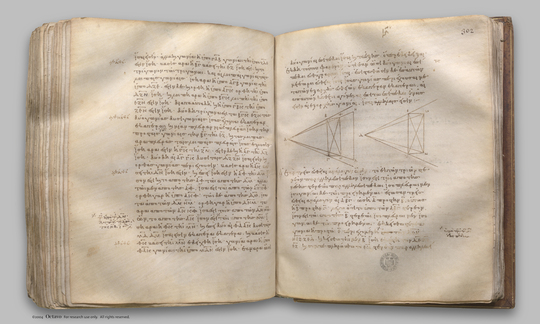index prev next | digilib folio 306

If three straight lines be proportional, the parallelepipedal solid formed out of the three is equal to the parallelepipedal solid on the mean which is equilateral, but equiangular with the aforesaid solid.
| Ἐὰν τρεῖς εὐθεῖαι ἀνάλογον ὦσιν, τὸ ἐκ τῶν τριῶν στερεὸν παραλληλεπίπεδον ἴσον ἐστὶ τῷ ἀπὸ τῆς μέσης στερεῷ παραλληλεπιπέδῳ ἰσοπλεύρῳ μέν, ἰσογωνίῳ δὲ τῷ προειρημένῳ. Ἔστωσαν τρεῖς εὐθεῖαι ἀνάλογον αἱ Α, Β, Γ, ὡς ἡ Α πρὸς τὴν Β, οὕτως ἡ Β πρὸς τὴν Γ: λέγω, ὅτι τὸ ἐκ τῶν Α, Β, Γ στερεὸν ἴσον ἐστὶ τῷ ἀπὸ τῆς Β στερεῷ ἰσοπλεύρῳ μέν, ἰσογωνίῳ δὲ τῷ προειρημένῳ. Ἐκκείσθω στερεὰ γωνία ἡ πρὸς τῷ Ε περιεχομένη ὑπὸ τῶν ὑπὸ ΔΕΗ, ΗΕΖ, ΖΕΔ, καὶ κείσθω τῇ μὲν Β ἴση ἑκάστη τῶν ΔΕ, ΗΕ, ΕΖ, καὶ συμπεπληρώσθω τὸ ΕΚ στερεὸν παραλληλεπίπεδον, τῇ δὲ Α ἴση ἡ ΛΜ, καὶ συνεστάτω πρὸς τῇ ΛΜ εὐθείᾳ καὶ τῷ πρὸς αὐτῇ σημείῳ τῷ Λ τῇ πρὸς τῷ Ε στερεᾷ γωνίᾳ ἴση στερεὰ γωνία ἡ περιεχομένη ὑπὸ τῶν ΝΛΞ, ΞΛΜ, ΜΛΝ, καὶ κείσθω τῇ μὲν Β ἴση ἡ ΛΞ, τῇ δὲ Γ ἴση ἡ ΛΝ. καὶ ἐπεί ἐστιν ὡς ἡ Α πρὸς τὴν Β, οὕτως ἡ Β πρὸς τὴν Γ, ἴση δὲ ἡ μὲν Α τῇ ΛΜ, ἡ δὲ Β ἑκατέρᾳ τῶν ΛΞ, ΕΔ, ἡ δὲ Γ τῇ ΛΝ, ἔστιν ἄρα ὡς ἡ ΛΜ πρὸς τὴν ΕΖ, οὕτως ἡ ΔΕ πρὸς τὴν ΛΝ. καὶ περὶ ἴσας γωνίας τὰς ὑπὸ ΝΛΜ, ΔΕΖ αἱ πλευραὶ ἀντιπεπόνθασιν: ἴσον ἄρα ἐστὶ τὸ ΜΝ παραλληλόγραμμον τῷ ΔΖ παραλληλογράμμῳ. καὶ ἐπεὶ δύο γωνίαι ἐπίπεδοι εὐθύγραμμοι ἴσαι εἰσὶν αἱ ὑπὸ ΔΕΖ, ΝΛΜ, καὶ ἐπ' αὐτῶν μετέωροι εὐθεῖαι ἐφεστᾶσιν αἱ ΛΞ, ΕΗ ἴσαι τε ἀλλήλαις καὶ ἴσας γωνίας περιέχουσαι μετὰ τῶν ἐξ ἀρχῆς εὐθειῶν ἑκατέραν ἑκατέρᾳ, αἱ ἄρα ἀπὸ τῶν Η, Ξ σημείων κάθετοι ἀγόμεναι ἐπὶ τὰ διὰ τῶν ΝΛΜ, ΔΕΖ ἐπίπεδα ἴσαι ἀλλήλαις εἰσίν: ὥστε τὰ ΛΘ, ΕΚ στερεὰ ὑπὸ τὸ αὐτὸ ὕψος ἐστίν. τὰ δὲ ἐπὶ ἴσων βάσεων στερεὰ παραλληλεπίπεδα καὶ ὑπὸ τὸ αὐτὸ ὕψος ἴσα ἀλλήλοις ἐστίν: ἴσον ἄρα ἐστὶ τὸ ΘΛ στερεὸν τῷ ΕΚ στερεῷ. καί ἐστι τὸ μὲν ΛΘ τὸ ἐκ τῶν Α, Β, Γ στερεόν, τὸ δὲ ΕΚ τὸ ἀπὸ τῆς Β στερεόν: τὸ ἄρα ἐκ τῶν Α, Β, Γ στερεὸν παραλληλεπίπεδον ἴσον ἐστὶ τῷ ἀπὸ τῆς Β στερεῷ ἰσοπλεύρῳ μέν, ἰσογωνίῳ δὲ τῷ προειρημένῳ: ὅπερ ἔδει δεῖξαι. | If three straight lines be proportional, the parallelepipedal solid formed out of the three is equal to the parallelepipedal solid on the mean which is equilateral, but equiangular with the aforesaid solid. Let A, B, C be three straight lines in proportion, so that, as A is to B, so is B to C; I say that the solid formed out of A, B, C is equal to the solid on B which is equilateral, but equiangular with the aforesaid solid. Let there be set out the solid angle at E contained by the angles DEG, GEF, FED, let each of the straight lines DE, GE, EF be made equal to B, and let the parallelepipedal solid EK be completed, let LM be made equal to A, and on the straight line LM, and at the point L on it, let there be constructed a solid angle equal to the solid angle at E, namely that contained by NLO, OLM, MLN; let LO be made equal to B, and LN equal to C. Now, since, as A is to B, so is B to C, while A is equal to LM, B to each of the straight lines LO, ED, and C to LN, therefore, as LM is to EF, so is DE to LN. Thus the sides about the equal angles NLM, DEF are reciprocally proportional; therefore the parallelogram MN is equal to the parallelogram DF. [VI. 14] And, since the angles DEF, NLM are two plane rectilineal angles, and on them the elevated straight lines LO, EG are set up which are equal to one another and contain equal angles with the original straight lines respectively, therefore the perpendiculars drawn from the points G, O to the planes through NL, LM and DE, EF are equal to one another; [XI. 35, Por.] hence the solids LH, EK are of the same height. But parallelepipedal solids on equal bases and of the same height are equal to one another; [XI. 31] therefore the solid HL is equal to the solid EK. |